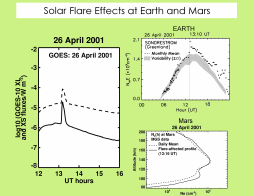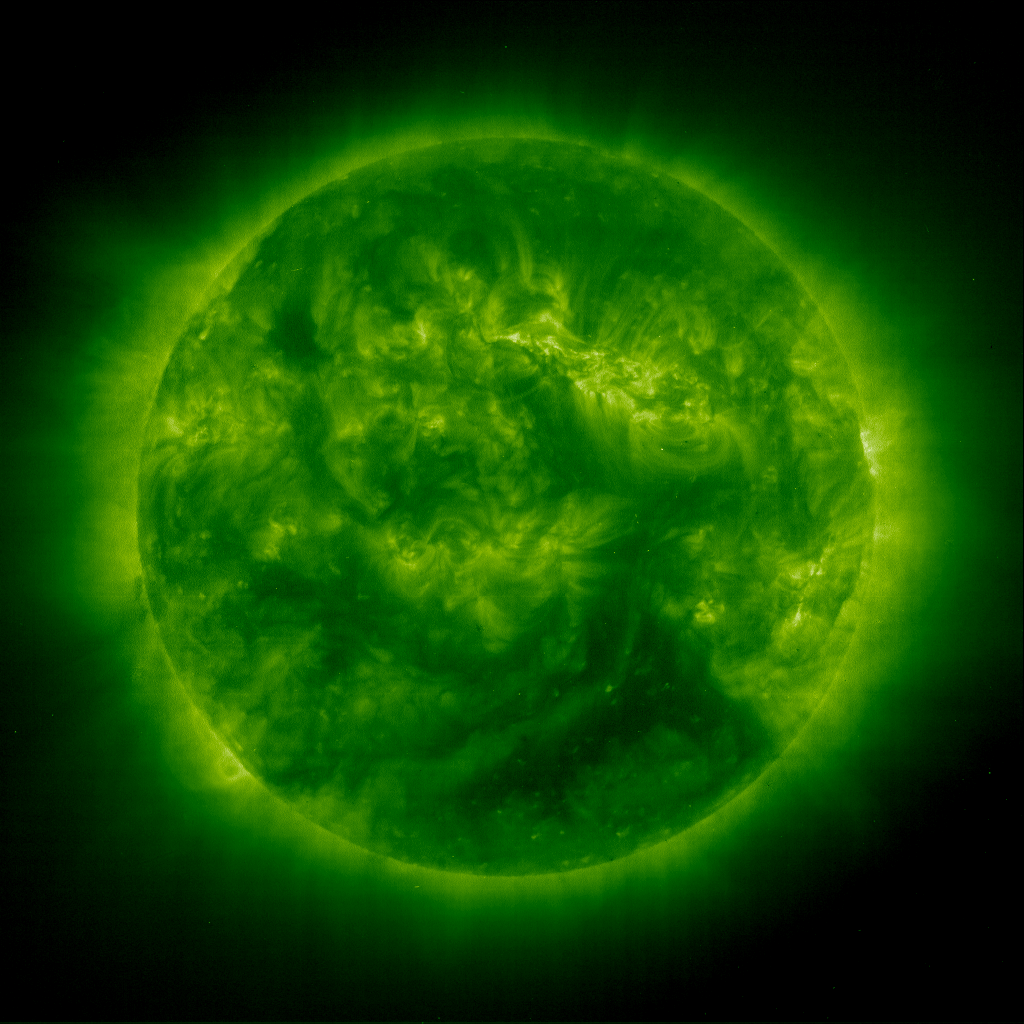News Release ****EMBARGOED NOT FOR RELEASE UNTIL 2:00 EST February 23, 2006 ****
BU SCIENTISTS DISCOVER MARS IONOSPHERE CHANGED BY FLARES FROM THE SUN
(Boston) – Boston University astronomers announced today the first clear evidence that solar flares change the upper atmosphere of Mars. In an article published in the February 24 issue of the journal Science, the researchers describe how X-ray bursts from the Sun in April 2001 recorded by satellites near Earth reached Mars and caused dramatic enhancements to the planet’s ionosphere – the region of a planet’s atmosphere where the Sun’s ultraviolet and X-rays are absorbed by atoms and molecules. The measurements were made by the Mars Global Surveyor (MGS) spacecraft at the Red Planet as it transmitted signals back to NASA’s antenna sites back on Earth.
“On April 15th and 26th of 2001, radio signals from MGS showed that the martian ionosphere was unusually dense, and this was the clue that some extra production of ions and electrons had occurred,” explained Michael Mendillo, professor of Astronomy, who led the BU research team in its Center for Space Physics.
Shown here is an example of the flare of 26 April 2001 and its effects at Earth and Mars. The X-rays recorded by the GOES spacecraft show a unambiguous flare with peak flux at 13:10 UT. At essentially the same time, an ionosphere observing station in Sondrestrom (Greenland), selected because it had a high latitude location comparable to the one for NASA’s Mars Global Surveyor (MGS), recorded a dramatic increase in the electron density of the terrestrial ionosphere. At Mars, the MGS observations just six minutes later showed large increases in the lower portions of the martian ionosphere. This is the first time that the same solar flare was seen to cause modifications to the upper atmospheres of two planets [credit: This figure was provided by the Center for Space Physics at Boston University.]
“At Earth, the GOES satellites measure the Sun’s X-rays almost continuously,” said Dr. Paul Withers at BU, “and our search of their large database discovered several cases of flares occurring just minutes before MGS detected enhancements in Mars’ ionosphere.” The extra electrons produced by the Sun’s X-rays cause subtle changes in how the MGS radiowaves travel towards Earth, and thus the team wanted to find several unambiguous case study events before announcing their findings.
This movie shows a rapid sequence of X-ray/ultraviolet images of the Sun made by the EIT instrument on the SOHO spacecraft. It begins at 12:00 UT (GMT) on April 26th, 2001, and ends a few hours later. It repeats continuously every few seconds. The bright flash in the upper right portion of the Sun’s disk is the solar flare. Within a few minutes, its X-rays reached Earth and then Mars to create extra ions and electrons in their ionospheres. [credit: These images were provided by the SOHO EIT Consortium; SOHO is a joint ESA-NASA program.]
The Radio Science Experiment on MGS has made observations of Mars’ ionosphere since its arrival there in late 1999. Its radio transmissions are received by NASA and then cast into scientifically meaningful data by Dr. David Hinson at Stanford University who provides open access to researchers worldwide via a website. “We needed Dr. Hinson’s expert advice to make sure that some odd changes in the MGS radio signal had not occurred just by chance,” Dr. Withers added.
To confirm that the photons from these flares had sufficient fluxes to actually modify an ionosphere, additional evidence was sought using measurements on Earth. “During this period, the Sun, Earth and Mars were nearly in a straight line and thus the X-rays measured at Earth should have caused enhancements here as well as at Mars,” Mendillo added. Using several ionospheric radars spread over the globe, operated by scientists at the University of Massachusetts/Lowell, Professor Bodo Reinisch confirmed that the Sun’s X-rays caused equally impressive modifications to Earth’s ionosphere at the precise times required on those days. “The science yield from this work will be in the new field of Comparative Atmospheres,” Mendillo pointed out. “By that I mean studies of the same process in Nature, in this case making an ionosphere on two planets simultaneously, offer insights and constraints to models not always possible when studying that process on a single planet. The fifth member of our team, Professor Henry Rishbeth of the University of Southampton in England, provides the expertise in theory and modeling that will be the focus of our follow-up studies.”
The BU-Stanford-UMASS-Southampton team published their joint paper in the US journal Science, with a publication date of 24 February 2006.
Additional Information:
Paper title: Effects of Solar Flares Upon the Ionosphere of Mars
Authors: Michael Mendillo, Paul Withers, David Hinson,
Henry Rishbeth and Bodo Reinisch
Reference: SCIENCE, 24 February 2006
Author Contacts:
- Professor Michael Mendillo, Center for Space Physics, Boston University (617) 353-2629, mendillo@bu.edu
- Dr. Paul Withers, Center for Space Physics, Boston University (617) 353-1531, withers@bu.edu
- Dr. David Hinson, Department of Electrical Engineering, Stanford University (650) 723-3534, dhinson@stanford.edu
- Professor Bodo Reinisch, Center for Atmospheric Research, University of Massachusetts/Lowell (978) 934-4903, Bodo_Reinisch@uml.edu
- Professor Henry Rishbeth, School of Physics & Astronomy, University of Southampton, UK, hr@phys.soton.ac.uk
Public Affairs at Boston University: Ms. Kira Edler, Science Editor (617) 353-2240 kedler@bu.edu




